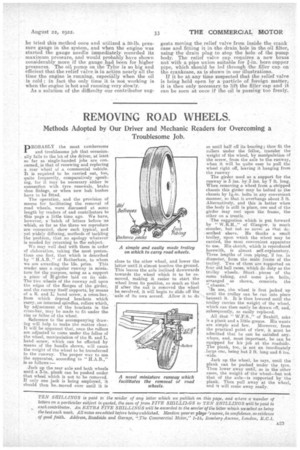REMOVING ROAD WHEELS.
Page 33

If you've noticed an error in this article please click here to report it so we can fix it.
Methods Adopted by Our Driver and Mechanic Readers for Overcoming a Troublesome Job.
PROBABLY the most cumbersome and troublesome job that, occasionally falls to the lot of the driver, at least so far as single-handed jobs are concerned,.is that of renewing and replacing a rear wheel el a commercial vehicle. It is required to be carried out, too, quite frequently, comparatively speaking, for it may be necessary either in connection with tyre renewals, brake shoe linings, or when new hub bushes have to be fitted.
The operation, and the provision of means for facilitating the removal of road wheels, were discussed at some length by readers of and contributors to this page a little time ago. We have, however, a batch of letters before us whioh, so far as the three we reproduce are concerned, show such typical, and yet widely differing, methods of tackling the problem, that .no apology whatever is needed for returning to the subject..
We may well deal with them in order of elaboration, taking the most pretentious one first, that which is described by " H.A.B.." of Rotherham, to whom -we are awarding the 15s. prize. This reader uses a .regular runway in miniature for the purpose, using as a support a piece of H-girder laid on its side. The two wheels of the runway roll upon the edges of the flanges of the girder, and the runway itself supports, by means of a R. and L. hand screw, a cross-bar, from which depend brackets which carry, on inturned spindles, rollers which, by adjustment of the bracketsin the crass-bar, may be made to fit under the rim or felloe of the wheel.
Reference to the accompanying drawing will help to make the matter clear. It will be apparent that, once the rollers are adjusted to come undar the felloe of the wheel, manipulation of the R. and L. hand screw, which can be effected by means of the handle shown, will cause the weight. of the wheel to be transferred to the runway. The proper way to use the apparatus, according to " H.A.B.," is as follows:— .Jack up the rear axle and both wheels until a 3-in, plank can be pushed under that wheel which is not to be removed. If only one jack is being employed, it should then be, moved over until it is
close to the other wheel, and lower the latter until it almost touches the ground. This leaves the axle inclined downwards towards the wheel which is to be removed, making it easier to start the wheel from its position, so much BO that if af0er the nut is removed the wheel be revolved, it will begin to slide off the 'axle of its own accord. Allow it to do so until half off its bearing ; then fit the rollers under the felloe, transfer the weight of the wheel, by manipulation of the screw, from the axle to the runway, when it will be quite easy to pull the wheel right, off, leaving it hanging from the runway The girder used as a support for the runway is 3 ins. by 3 ins. by 7 ft. long. When removing a wheel from a stripped chassis this girder may be bolted to the chassis by 1k-in bolts in any convenient manner, so that it overhangs about 3 ft. Alternatively, and this is better when the body is still in place, one end of the girder may rest upon the frame, the other on a trestle.
-The suggestion which is put forward by " W.R.H.," of Glasgow. is much simpler, but not so novel as that described above. He thinks a small trolley, upon wnich the wheel may be carried, the most convenient apparatus to use. His sketch, -which is reproduced herewith, is almost self-explanatory. Three lengths of iron piping, 2 ins. in diameter, form the main frame of the trolley. Two of them are supported on four old ball races, which do duty as the trolley wheels.. Short pieces of the same tubing, and some On. bolts, arranged as shown, comulete the " chassis."
‘qtt use, the wheel is first jacked up until the trolley can be run into place beneath it. It is then lowered until the trolley carries the weight of the wheel, which can then easily be drawn off, and, subsequently, as easily replaced.
All that " W.F.S.," of Bexhill, asks is a plank and a little grease. His wants are simple and few. Moreover, from the practical point of view, it must be admitted that he can be satisfied anywhere, and, most important. he can be equipped for his job at the roadside. The plank, too,, is not an inordinately large one, being but 2 ft. long and.6 • wide.
Jack up the wheel, he says, until the plank can be pushed under the tyre. Then lower away until, as in the other cases, the weight of -the wheel—but not that of the axle—is supported by the plank. Then pull away at the wheel, and it will come away easily.


































